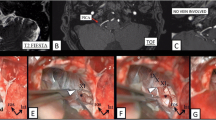Abstract
Background
The clinical course of abducens nerve palsy associated with skull base tumour is rarely reported. In this study, we examined the post-operative course of abducens nerve palsies associated with various skull base tumours.
Method
Between January 2003 and December 2006, 240 patients with various skull base tumours underwent surgery at Kyushu University Hospital. Among them, nine patients presented with abducens nerve palsies (ten nerves) following surgery. The conditions included two pituitary adenomas, two trigeminal schwannomas and five meningiomas. We evaluated the function of the abducens nerves in these patients on admission, at discharge, and periodically in the outpatient clinic.
Findings
Four of the abducens nerve palsies already existed prior to surgery, and six of them developed post-operatively. In the four patients with pituitary adenomas and trigeminal schwannomas, all nerves were anatomically preserved and showed complete recovery of function within 6 months after surgery. In contrast, only two of the six palsies in patients with skull base meningiomas showed complete recovery. In three patients with petro-clival meningiomas, the abducens nerves were completely transected during surgery, and one was reconstructed using fibrin glue. This patient remarkably recovered from the abducens nerve palsy within 2 years.
Conclusions
The abducens nerve palsies in pituitary adenomas and trigeminal schwannomas showed a better clinical course compared to those in skull base meningiomas. The abducens nerve palsies that occur with skull base meningiomas are less likely to recover. Nevertheless, it is important to preserve the nerves and to perform surgical repair if the nerve is transected.




Similar content being viewed by others
References
DeMonte F, Smith HK, Al-Mefty O (1994) Outcome of aggressive removal of cavernous sinus meningiomas. J Neurosurg 81:245–251
Dolenc VV (1997) Trans-cranial epidural approach to pituitary tumours extending beyond the sella. Neurosurgery 41:542–552. doi:10.1097/00006123-199709000-00007
House JW, Brackmann DE (1985) Facial nerve grading system. Otolaryngol Head Neck Surg 93:146–147
Iaconetta G, Fusco M, Cavallo LM, Cappabianca P, Samii M, Tschabitscher M (2007) The abducens nerve: microanatomic and endoscopic study. Neurosurgery 3(Suppl):7–14. doi:10.1227/01.neu.0000289706.42061.19
Iaconetta G, Fusco M, Samii M (2003) The spheno-petro-clival venous gulf: a microanatomical study. J Neurosurg 99:366–375
Kleihues P, Cavenee WK (eds) (2000) World Health Organisation classification of tumours. Pathology and genetics of tumours of the nervous system. IARC Press, Lyon
Morita A, Coffey RJ, Foote RL, Schiff D, Gorman D (1999) Risk of injury to cranial nerves after gamma knife radiosurgery for skull base meningiomas: experience in 88 patients. J Neurosurg 90:42–49
Sandvoss G, Stoltenburg-Didinger G, Yasargil MG (1987) Experimental trans-clival exposure and repair of the abducens nerve in cats. Neurochirurgia (Stuttg) 30:65–68
Sawamura Y, Ikeda J, Miyamachi K, Abe H (1997) Full functional recovery after surgical repair of transected abducens nerve: case report. Neurosurgery 40:605–608. doi:10.1097/00006123-199703000-00034
Scott AB, Kraft SP (1985) Botulinum toxin injection in the management of lateral rectus paresis. Ophthalmology 92:676–683
Sekhar LN, Lanzino G, Sen CN, Pomonis S (1992) Reconstruction of the third through sixth cranial nerves during cavernous sinus surgery. J Neurosurg 76:935–943
Author information
Authors and Affiliations
Corresponding author
Additional information
Comment
Surgery of petroclival lesions is often extremely complicated due to the intrinsic anatomical complexity of the area. Every surgeon challenging with these lesions knows that. The paper written by Shono et al. reports their experience about sixth nerve palsy in nine patients operated on because of meningioma, neurinoma, and adenoma. Soft lesions like adenomas can slightly displace the nerve; hard lesions such as meningiomas very often damage the nerve permanently due to direct compression and stretching mechanism causing ischemia also because of the vasa nervorum injury. I found the paper well written and pertinent to other reports.
Giorgio Iaconetta
University of Naples, Italy
Rights and permissions
About this article
Cite this article
Shono, T., Mizoguchi, M., Yoshimoto, K. et al. Clinical course of abducens nerve palsy associated with skull base tumours. Acta Neurochir 151, 733–738 (2009). https://doi.org/10.1007/s00701-009-0312-7
Received:
Accepted:
Published:
Issue Date:
DOI: https://doi.org/10.1007/s00701-009-0312-7




